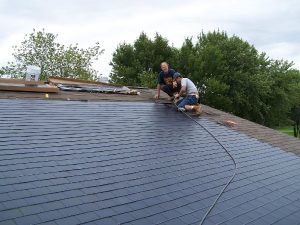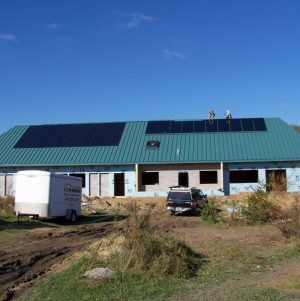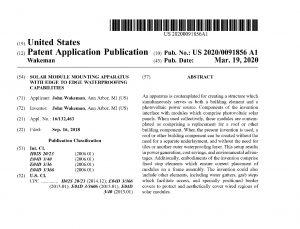BIPV Experience… Since 2004
2004 solar shingles


Uni-Solar thin film solar shingles
Uni-Solar was a Michigan company based on thin film deposition of amorphous silicon. The product was a flexible shingle, with efficiency below 6%. The material and labor cost was twice that of a standard solar module installation. As is visible in the photo, the edge of the roof had to be standard shingles. While these problems were road blocks to wide adaptation, we are happy for the experience of working with this early solar roofing, and potentially disruptive technology.
Solar PV Rainscreen
BIPV wall facade- wire for others
This installation shows a custom solar module installed in a rainscreen frame developed by others. Watershed Solar Roofing personnel wired the balance of system and took care of electrical permitting and inspection. (Installation shown below.)

Modules installed by glazier (not associated with Watershed Solar Roofing)
BIPV Rainscreen (Building Integrated Photovoltaic)

Unlike other rainscreens this one will generate electricity. Unlike the Watershed Solar Roofing system these solar modules are custom built at low volume, with all the associated costs and concerns.

Other BIPV Installations
Solar Laminate on steel raised seam roof
Many products called “BIPV” do not actually act as a waterproofing cladding. This product is an example of that. It was adhered to the metal roof like a big sticker. This photo shows a PV laminate on the left side of the roof and a solar hot water array on the right side of the roof.
This photo is another example of a laminate adhered to a standing seam metal roof.



It is these very experiences- the frustrations and challenges of working with these products and projects that inspired us to develop our patent-pending Watershed Solar Roofing BIPV roofing system.
Our System…
Unlike the rest of the BIPV on this page our modules are manufactured in megawatt quantities, taking advantage of economies of scale to deliver low cost and high efficiency. The modules go edge-to-edge, increasing the area by as much as 100% compared to systems that require conventional shingles around all four edges.